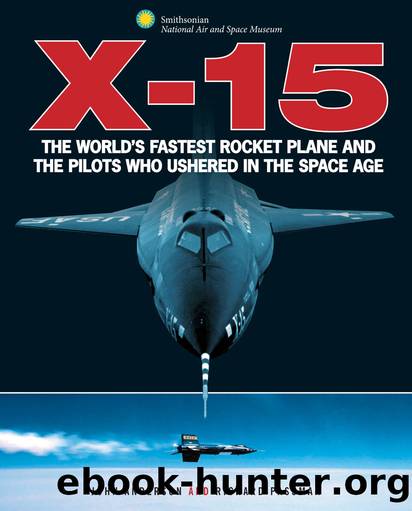X-15 by John Anderson

Author:John Anderson
Language: eng
Format: epub
Publisher: MBI
Published: 2014-03-15T00:00:00+00:00
JOSEPH A. WALKER
1921â1966
Joe Walker flew the X-15 for his first time on March 25, 1960, during which he achieved Mach 2.0 and an altitude of 48,630 feet. He was the first NASA pilot in the test program.
Walker in the cockpit before a flight. USAF, Air Force Flight Test Center History Office, Edwards Air Force Base
Walker in the cockpit preparing for a flight. USAF, Air Force Flight Test Center History Office, Edwards Air Force Base
Joe Walker was born on February 20, 1921, in Washington, Pennsylvania. He graduated with a bachelor of arts degree in physics from Washington & Jefferson College in 1942. He was caught up in the storm of World War II, joined the Army Air Force, and flew P-38 fighters in North Africa, for which he earned the Distinguished Flying Cross and the Air Medal with seven Oak Leaf clusters. In March 1945, he joined the NACA and became involved in the icing research program at the Aircraft Engine Research Laboratory (now the NASA Glenn Research Laboratory) in Cleveland, Ohio. There, in the words of Milton Thompson, himself an X-15 pilot, Joe Walker âspent many hours droning around in the crappiest winter weather that they could find in the Great Lakes region.â [citation: Milton O. Thompson, At the Edge of Space: The X-15 flight Program (Smithsonian Institution Press, 1992, p. 4)]
Walker transferred to the NACA High Speed Flight Station (later the Dryden Flight Research Center) in 1951, and his flying skills earned him the position of chief pilot in 1955. He flew as project pilot on some of the early, important high-speed experimental airplanes, including the Douglas D-558-1 and 2 and the Bell X-1A and X-1E, X-3, X-4, and X-5. During his first year at the NACA High Speed Flight Station, Walker received an NACA medal for heroism. He was in the cockpit of the X-1A mounted in the bomb bay of a B-29 in flight. In preparation for his research flight, he pressurized the X-1Aâs propellant tank. An explosion immediately occurred, and Walker passed out. Regaining consciousness as the B-29 crew opened the X-1A canopy and pulled him out, Walker realized that the X-1A had to be deactivated before a bigger explosion occurred. Risking his life, Walker crawled back into the cockpit and depressurized the remaining tanks. The smell of hot peroxide started to fill the B-29. The X-1A now resembled a bomb about ready to go off. Scrambling back into the B-29, Walker decided to jettison the X-1A. The experimental airplane spun down to the desert floor and was destroyed, but the B-29 and its crew returned safely.
In 1959, the NACA became part of the newly formed National Aeronautics and Space Administration. Hence, on March 25, 1960, Walker became the first NASA pilot to fly the X-15. Remarkably, on his first flight, Walker took the X-15 to Mach 2 and an altitude of 48,630 feet. During the course of his remaining twenty-four flights in the X-15, Walker achieved the highest altitude of all the X-15 flights, 354,200 feet on Flight 91, August 22, 1963.
Download
This site does not store any files on its server. We only index and link to content provided by other sites. Please contact the content providers to delete copyright contents if any and email us, we'll remove relevant links or contents immediately.
Kathy Andrews Collection by Kathy Andrews(10544)
The remains of the day by Kazuo Ishiguro(7572)
Spare by Prince Harry The Duke of Sussex(4217)
Paper Towns by Green John(4175)
The Body: A Guide for Occupants by Bill Bryson(3813)
Be in a Treehouse by Pete Nelson(3231)
Harry Potter and the Goblet Of Fire by J.K. Rowling(3066)
Goodbye Paradise(2973)
Never by Ken Follett(2905)
Into Thin Air by Jon Krakauer(2711)
The Remains of the Day by Kazuo Ishiguro(2626)
The Genius of Japanese Carpentry by Azby Brown(2613)
The Cellar by Natasha Preston(2603)
Drawing Shortcuts: Developing Quick Drawing Skills Using Today's Technology by Leggitt Jim(2535)
120 Days of Sodom by Marquis de Sade(2444)
Architecture 101 by Nicole Bridge(2356)
Machine Learning at Scale with H2O by Gregory Keys | David Whiting(2309)
The Man Who Died Twice by Richard Osman(2305)
Industrial Automation from Scratch: A hands-on guide to using sensors, actuators, PLCs, HMIs, and SCADA to automate industrial processes by Olushola Akande(2113)
